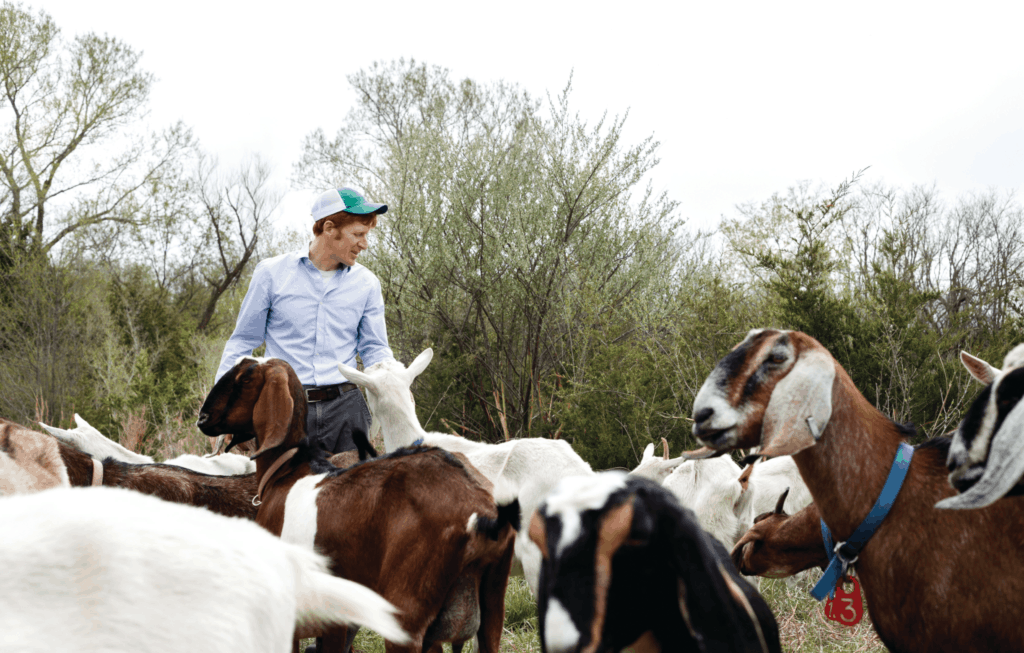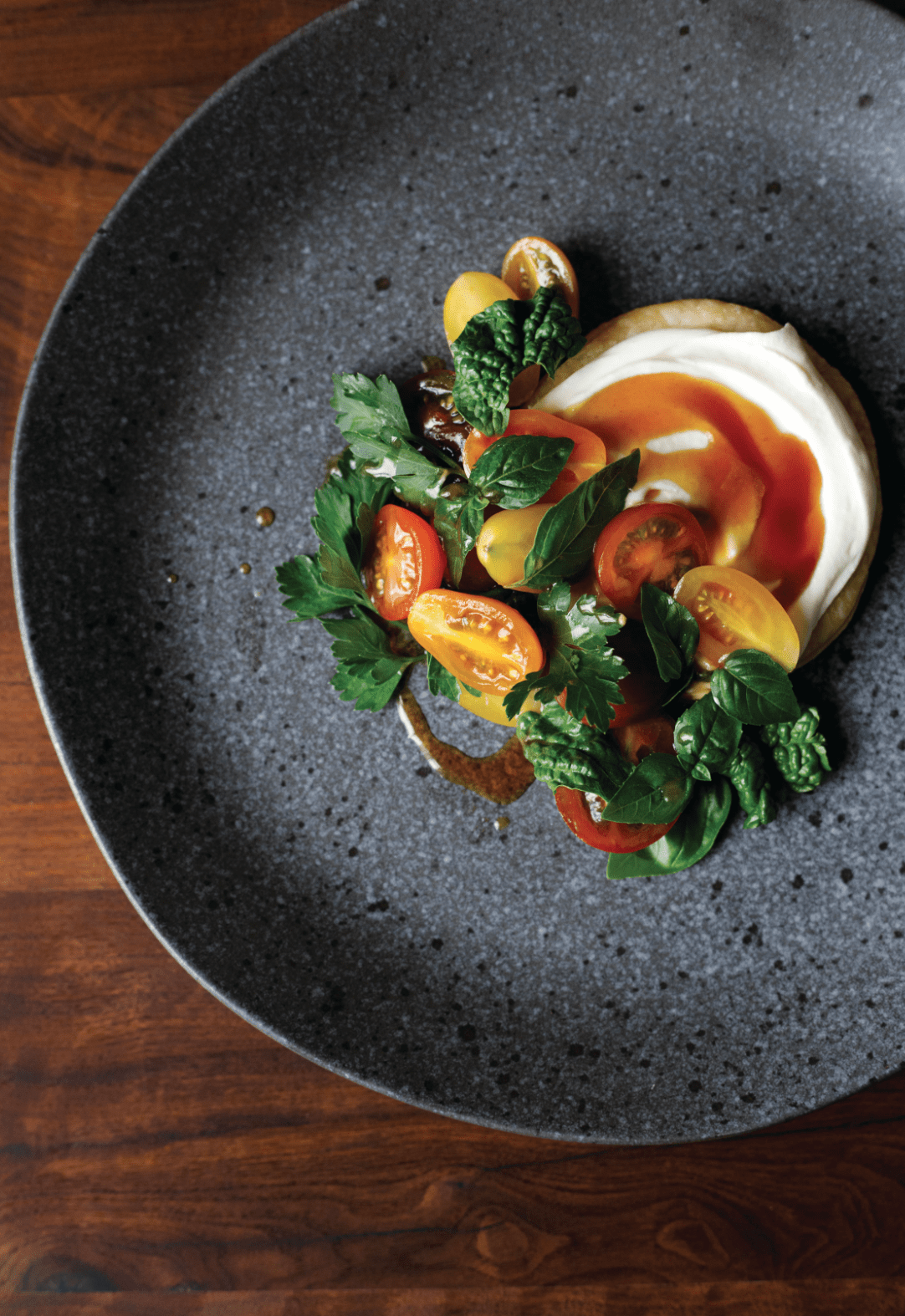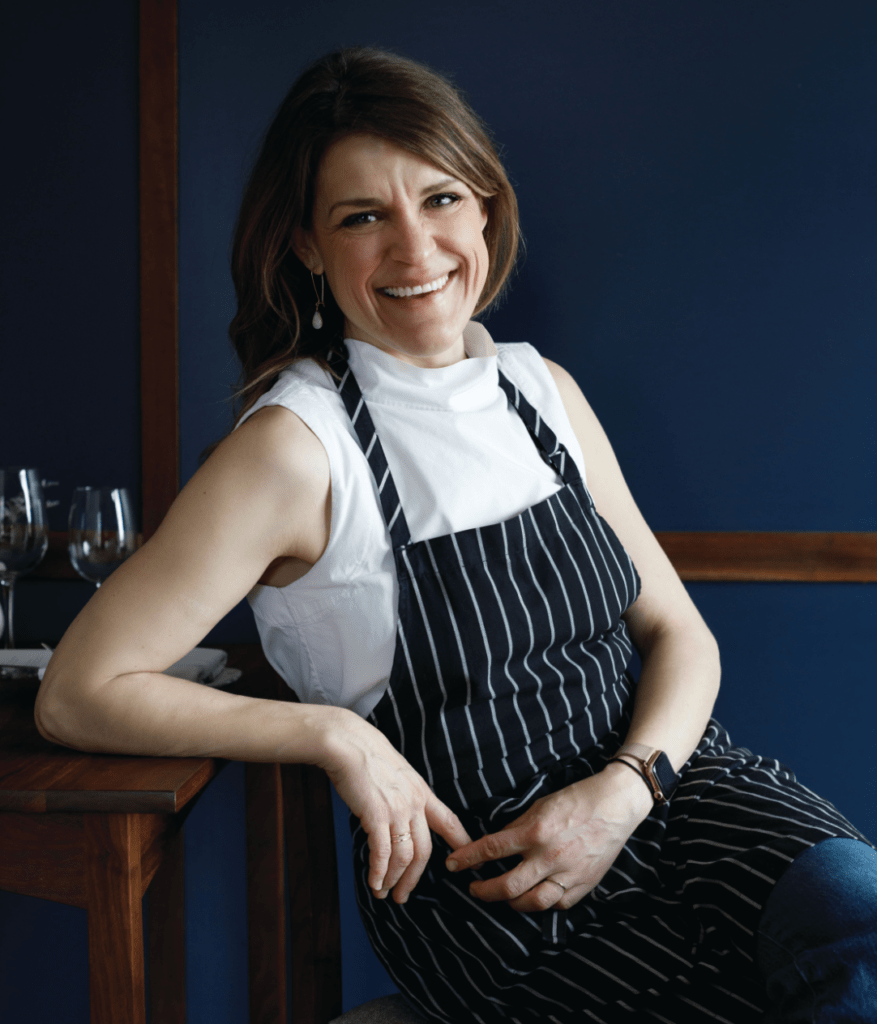Photographed by Gavin Peters
Ten miles north of downtown Wichita, Kansas, the small town of Kechi (pronounced “kee-chi”) is home to just shy of 2,000 residents, a nationally renowned art glass gallery, and since 2010, Elderslie Farm. On their 100 acres, George and Katharine Elder make artisan goat’s and cow’s milk cheeses, along with operating a restaurant, a cafe, a seasonal blackberry-picking operation, and a sawmill. This diversity, and the Elders’ thoughtful, sustainable approach to farming and food production, make Elderslie an anomaly in Kansas, where agriculture covers 90 percent of the land area. Most of this vast acreage is devoted to wheat, grain sorghum, and beef cattle; there are few dairy farms and even fewer small farmstead creameries like Elderslie.

“The only way to explain the breadth of what we’re doing is that it didn’t come out of a business plan, it came out of a poetic affection,” says George, who was born and raised on the farm. While his family’s longtime livelihood had been a Wichita-based corrugated box business, his parents, Philip and Becky Elder, embraced the practical and philosophical aspects of agrarian life, which they imparted to their seven children. “We talked a lot about land stewardship around the dinner table,” says George. “The conversation would move from discussions of Henry V to discussions of William Wordsworth’s lyrical ballads to discussions of Wendell Berry’s essays on the ecological dilemma of the Appalachian coal mines.” Reading Wordsworth, Berry, and James Rebanks, a UK sheep farmer and author of The Shepherd’s Life—as well as a job in high school installing wood trim—contributed to George’s deepening interest in the preservation of local culture, and the launch in 2009 of Elderslie Woodworks.
 Nearly all of the wood sawn and fabricated into bar tops and tables—including those for the farm’s Elderslie restaurant and Bramble Cafe—is native to Kansas. The same sensibility, which respects geographic distinction and time-honored methods, drives the rest of the farm’s operations. “The blackberries came about as a way to incorporate and enrichen the way we were serving and using the land, and the restaurant came about as an outgrowth of Katharine’s family’s investment in the culture of the table,” says George.
Nearly all of the wood sawn and fabricated into bar tops and tables—including those for the farm’s Elderslie restaurant and Bramble Cafe—is native to Kansas. The same sensibility, which respects geographic distinction and time-honored methods, drives the rest of the farm’s operations. “The blackberries came about as a way to incorporate and enrichen the way we were serving and using the land, and the restaurant came about as an outgrowth of Katharine’s family’s investment in the culture of the table,” says George.
While he and Katharine knew each other growing up, their paths subsequently diverged. “I was singing opera while George was shooting ducks,” she says with a laugh. “My mom’s sister lives in Milan, and I remember realizing that I wasn’t Italian although we were raised with a very Italian-like elevation and celebration of the table.” Frequent travel to Italy exposed her to ingredients that were then unavailable in the U.S., like arborio rice, and her mother would often return from travels to France with suitcases full of cheese. Following a harrowing bicycle accident that landed Katharine in the hospital, George went to see her, and their friendship was rekindled. They were married on the farm in 2011 and opened the Bramble Cafe the following year, in time for blackberry season. “George asked me if I would check in people to do you-pick and I had that moment of, ‘Is this going to be the rest of my life?’” Katharine says. “I told him, ‘Sure, but I’m making breakfast.’” The result, Bramble Cafe, serves casual morning fare such as blackberry-lavender muffins and a savory bread pudding made with local vegetables, eggs, and bacon. Elderslie restaurant, which Katharine also launched in 2012 in the farmhouse, now offers a cheese-focused appetizer menu as well as a four-course, prix fixe menu with optional wine pairings in a quietly elegant dining room and on a spacious patio.
“We have an interesting intermix of George having been raised around a table talking policy and ideas—the why behind everything—and at our table we talked about food,” says Katharine. “I remember it being very disorienting at the dinner table when we were first married because I would cook expecting to talk about it and George would just eat and not say much; I would think, ‘Is it OK?’ We have since landed somewhere in the middle talking about, cheese, which was something very near and dear to my family growing up.”
The creamery, which opened in 2020, added another layer of connectivity to Elderslie Farm. “It’s been really fun as a chef to get to watch George in the art of cheesemaking, and to work with an ingredient that the producer cares about,” Katharine says. “And an incredible challenge to learn how to intertwine the restaurant and the creamery. They work together well and provide a lot of symbiosis.” Her appetizer menu includes a newer release, Cloverdale—a raw goat’s milk cheese—baked in a French boule with lavender and honey. It’s Katharine’s favorite of the Elderslie cheeses. “George had been working for a long time on our Cloudydale, which has a lactic ash rind—very French, very pungent. Cloverdale is the same geometry—a larger crottin shape—but it’s a Brie-style cheese. You get a little punchiness of the goat milk in the center, but it’s not so aggressive as to turn off a newbie to these French styles. I eat way too much of it but it’s fun to cook with.”

After a many-month hiatus due to the pandemic, Elderslie, “a root-to-leaf restaurant,” reopened in April. The spring menu featured local beans, beef, and honey in addition to Elderslie Caprino Fresco goat cheese in a poppy seed cheesecake for dessert. “I’m a big keyword person, and for Elderslie it’s ‘refined, convivial, and authentic,’” says Katharine. While the prix-fixe menu distinguishes the restaurant from other local- and seasonal- food–focused restaurants in the area, the appetizer menu offers more flexibility. “It gives us a chance to share more about our cheese and gives customers a chance to enjoy Elderslie without the same commitment of time or resources,” she says. With two young children and a multi-faceted business to run, Katharine has embraced life on a small Kansas farm. “George gave me a challenge when we were married because I was very concerned about not being able to travel, being married to a farmer,” she recalls. “He said, ‘If you spent as much of your energy making this where you want to be as you do trying to get elsewhere, I think you might be surprised.’ I love a good challenge, and we’ve gotten an opportunity to build a place that is peculiar to Kansas in that there aren’t lots of little farms dotting the countryside, but we get to provide respite and an authentic experience for people that celebrates their land and where they’re from.” George sees things from a less rosy, characteristically philosophical perspective. “I blame Wordsworth,” he says. “The involvement in agriculture has brought me to the most poignantly beautiful and darkest moments of my life. The pleasant surprise for me is that those moments, those touches with that bitterness, have made things like spring flowers sweet.”

Whipped Goat Cheese Tart with Tomato-Herb Salad
Ingredients
TART CRUST
- 1 ¾ cups all-purpose flour
- ½ cup toasted pine nuts cooled
- 1 cup unsalted butter cut into pieces
- ½ - ¾ cup ice cold water
- 2 teaspoons salt
WHIPPED GOAT CHEESE
- 1 cup fresh goat cheese
- ¼ cup cream cheese
- Zest of one lemon
- 2 tablespoons heavy whipping cream
- 1 teaspoon salt
SHERRY-HONEY REDUCTION
- 1 cup sherry vinegar
- ½ cup honey
TOMATO SALAD
- 2 cups cherry tomatoes halved
- Dash of salt to taste
- 1 teaspoon extra virgin olive oil
- Zest of two lemons
- 1 teaspoon sherry honey reduction
- 1 ½ cups fresh small basil leaves Other whole leaf-herbs, spinach, or arugula may be substituted
TO SERVE
- Fresh whole-leaf herbs
- Sherry-honey reduction
Instructions
- ►CRUST: Add flour, pine nuts, and salt to a food processor and blend until mixture resembles coarsely-ground meal. Add butter and pulse until combined. Add ice water a tablespoon at a time until dough comes together. Refrigerate 90 minutes or overnight. Preheat oven to 325°F and line a baking sheet with parchment paper. Remove dough from fridge and roll out to large circle, -¼ inches thick. Cut four circles five inches in diameter and prick all over with a fork. Transfer to baking sheet and bake 12 minutes or just until pastry is golden brown and slightly puffy.
- ►FILLING: Melt cheeses together in a small saucepan over medium low heat. Remove from heat, add cream, lemon zest, and salt and chill thoroughly. Whip using a hand mixer or stand mixer until fluffy.
- ►SHERRY-HONEY REDUCTION: Place sherry vinegar and honey in a small saucepan. Simmer until reduced by half and slightly tacky, 20-30 minutes.
- ►SALAD: Toss tomatoes with salt, olive oil, lemon zest, and sherry honey reduction. Gently fold in basil.
- ►TO SERVE: Place a dot of whipped goat cheese on the center of four plates and place a tart crust on the cheese to keep it from slipping. Spoon a generous dollop of cheese onto crusts and use back of spoon to gently smooth cheese to edges. Divide tomato salad evenly among the plates, arranging it alongside tart. Garnish with fresh herbs and drizzle with additional sherry-honey reduction.






